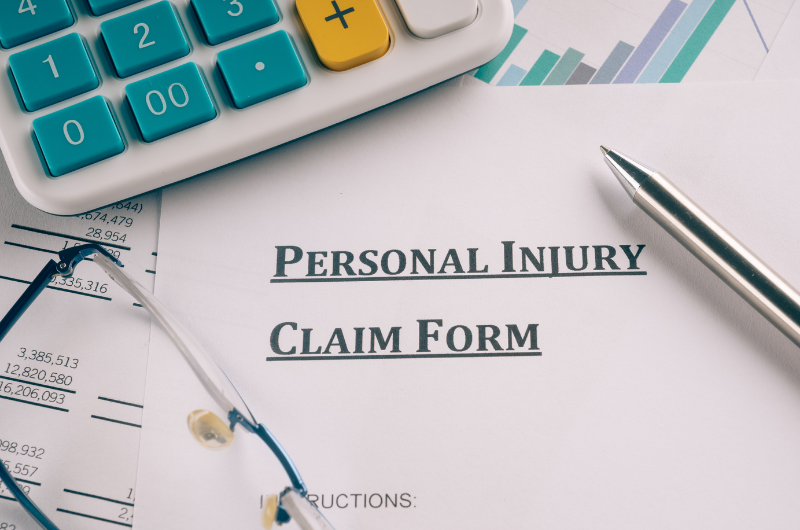When an individual suffers personal injury in an accident involving another party, they often want to have the responsible party pay. Medical expenses, lost income, and property damage can be devastating costs to the average American. Navigating the process of pursuing litigation, especially when still recovering from the trauma of a physical injury, can be a stressful and confusing experience for injury victims.
Personal injury attorneys help accident victims understand the law and how to successfully pursue compensation for damages incurred. While consultation with a local experienced personal injury attorney is always the best course of action to take, this article aims to provide readers with some basic information on what a personal injury claim is, how the law determines compensation, and common types of personal injury cases.
Legal Definitions of ‘Personal Injury’
Throughout the course of everyday life, countless Americans are involved in an accident of some kind. When individuals suffer personal injury due to their own negligence that caused an accident, they often have little to no recourse, since their injuries resulted from their own actions. However, when the accident and subsequent personal injury is instead due to someone else’s negligent behavior, then the injured individual may have grounds for pursuing litigation.
Essentially, this is how the majority or courts across the United States define personal injury law. In order for a plaintiff to prove to the court that someone else’s negligence was responsible for the accident, they must show the court that the other individual had what is known as a “duty of care.” This duty of care can be conceptualized as any reasonable expectation to keep other people safe from harm. Examples of a duty of care include driving responsibly on the road or warning any house guests about potential hazards around the home.
The plaintiff and their personal injury attorney must subsequently show the court that the defendant failed or “breached” their duty of care towards the plaintiff. Taking the examples mentioned previously, a breach of the duty of care could be engaging in reckless or distracted driving or failing to warn house guests about a tripping hazard located on the property. When this breach of duty results in an individual incurring personal injury, the injured person will likely have grounds for pursuing litigation and should consult with an experienced local personal injury attorney as soon as possible.
Negligence in Personal Injury Law
When conceptualizing and building out a personal injury case for court, the plaintiff’s legal team must consider the role that negligence has played in the events leading up to the accident. Each state develops their own system of fault determination to be applied to personal injury cases, and Illinois is no different.
According to Illinois state law, the system of fault determination the court will use to scrutinize a case is known as “modified comparative negligence.” Under this system, a plaintiff may be eligible for recovering compensation for damages only if he or she is determined to be less than 50% at fault for the events that lead to the accident. In other words, If the plaintiff is more than halfway at fault for the incident, they will lose any hope of recovering monetary compensation for their injuries.
One important factor that prospective plaintiffs must therefore consider before deciding to pursue litigation is the degree of fault they realistically bring to the case. Although there are certainly cases where an individual’s personal injuries are solely due to the negligent behavior of another individual, in some cases this responsibility is instead shared by both parties. For example, perhaps a prospective plaintiff wants to sue because they were sideswiped by a distracted driver and suffered a neck injury, but the injured driver was also rolling through a right turn on red at the point of collision.
When a plaintiff decides to bring their case to court after consulting with their personal injury attorney, it is important that they also understand how damages are awarded. In a situation where the plaintiff is less than halfway responsible for the accident and is awarded compensation for damages by the court, the ultimate level of compensation the plaintiff will receive will be reduced by a degree that is proportional to the level of fault they share for the accident. Taking the above example, if the injured driver was deemed to be 25% at fault for rolling through the red light, the final amount of compensation for damages awarded by the court will be reduced by 25%, reflecting the plaintiff’s role in the accident.
Types of Damages in Personal Injury Cases
Once the injured party has consulted with an experienced local personal injury attorney about the validity of their case, it is time to prepare for court, where financial compensation for damages will be awarded. For many average citizens, an understanding of the different types of damages available may prove elusive. This section aims to present some basic information on the different types of damages often recognized and awarded by personal injury courts.
Compensatory damages are what many injured plaintiffs envision when they discuss pursuing litigation against a negligent party. As the name suggests, compensatory damages are meant to “compensate” the plaintiff for any expenses resulting from the accident. Common types of compensatory damages include:
- Medical care: When a bodily injury is significant enough to warrant treatment, the medical bills can quickly become overwhelming to the average citizen. Compensatory damages awarded by the court will almost always include line items for the cost of medical care received as well as the anticipated costs of future medical treatment for longstanding injuries.
- Lost income: Recovering from an accident takes time, meaning many plaintiffs need to miss work for a period of days, weeks, or even months. Compensatory damages can address the income already lost from wages and time off work, as well as any future anticipated time the injured person will need to miss for care related to the injury.
- Property damage: When the plaintiff’s vehicle or other personal items were damaged in the accident, compensatory damages can be used to pay for the repair or replacement of these items.
When a defendant’s behavior is judged by the court to be severely reckless, the plaintiff may be awarded punitive damages as well. Although these damages are awarded to the plaintiff, they are meant to “punish” or send a message to the defendant that their actions have severe consequences. There is often a limit placed on how much a court can award in punitive damages. This limit is typically calculated as a certain multiple of the total compensatory damages awarded in a case.
Different Types of Personal Injury Cases
All types of personal injury cases involve proving the defendant was negligent and that this negligence was the cause of the injuries the plaintiff suffered. Some common types of personal injury cases presented to courts include:
- Car accidents: When a driver causes an accident by driving recklessly or distracted, this behavior is often construed as negligent by the court. Plaintiffs must ensure that their own driving behavior at the time of the accident was not negligent and contributory to the outcome.
- Dog bites: When a person’s dog bites another individual and causes personal injury, the victim will likely have legal recourse in pursuing compensation for damages incurred. The plaintiff must ensure that they were legally on the premises at the time of the attack and they were not provoking the dog.
- Injuries on private property: Homeowners maintain a duty to warn guests of any potential hazards that may cause them to trip or otherwise incur personal injury. When a homeowner fails in this duty to warn or otherwise address hazards on their property, they may be deemed liable for any damages an accident victim incurs as a result.
- Medical malpractice: When a person suffers personal injury due to the negligence of a healthcare provider, they may be able to recover compensation for damages incurred due to the effects of medical malpractice.
- Workers’ compensation: A person’s occupation can lead to all types of injuries in the workplace. Whether it was a minor accident or a more serious injury, it’s possible to get compensation. In some cases, worker deaths can even lead to a wrongful death lawsuit.
Statute of Limitations
No matter what the circumstances surrounding an individual’s personal injury case, it is important that prospective plaintiffs be aware of the statute of limitations. Illinois state law maintains a two-year statute of limitations for filing a personal injury lawsuit for most cases. There are numerous exceptions to this general rule. For example, cases against a municipal defendant typically carry a one year statute of limitations. For accident victims who attempt to file their case with the courts outside of the statutory time limit, they are almost certain to be denied the opportunity to pursue litigation and recover compensation for damages. This is why contacting a local personal injury attorney soon after the accident is always the best course of action.
Getting A Personal Injury Lawyer
For individuals attempting to wade through the various legal obstacles (in addition to dealing with insurance companies) involved in recovering monetary compensation for damages incurred in an accident, the process can seem insurmountable. This is where the value of working with a trusted local personal injury attorney comes into play. For years, the attorneys at the law firm of Palermo Law Group have been helping accident victims in Oak Brook and throughout Chicagoland understand the litigation process. Contact Palermo Law Group today for a free consultation if you or a loved one need expert legal advice on a personal injury case.


